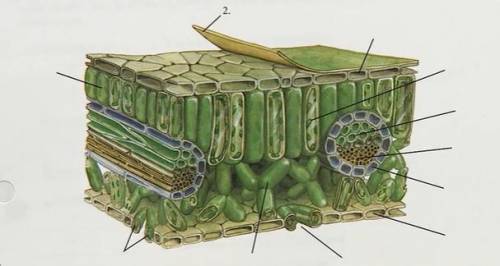
Supply the missing terms based on the definitions given. Then in the cross section of the leaf, label each structure that has a line pointing to it, using the number of each term as your label.
1. _ (hint: tissue in which most photosynthesis takes place)
2. Cuticle
3. _ (hint: protects the top of the leaf)
4._ (hint: organelle that contains chlorophyll)
5._ (hint: brings water from the roots to a leaf)
6._ (hint: transports sugar solution throughout a plant)
7._ (hint: supports a leaf and is composed of vascular tissue)
8._ (hint: protects the bottom of a leaf)
9._ (hint: an opening for the exchange of gases)
10._ (hint: tissue that contains many air spaces)
11._ (hint: regulate the flow of gases into and out of the stomata)


Answers: 3


Another question on Biology

Biology, 21.06.2019 14:00
Which process must a cell undergo top identical cells at the end of cell division
Answers: 3

Biology, 21.06.2019 23:00
Some technological solutions to problems like global warming meet the specific needs and situations of local communities. an example from india involves converting the solid waste from cattle into clean-burning fuel for cooking. this reduces the amount of greenhouse gases, specifically methane and carbon dioxide, released into the environment from wood fires. when evaluating the feasibility of implementing this solution, computer models are used to weigh costs against benefits. what factor is least likely to impact the decision on adopting this technology?
Answers: 1


Biology, 22.06.2019 06:50
The kidney filters potentially toxic substances in the blood, and thus “clears” the blood of those substances. this clearance function is dependent upon and proportional to the diffusion gradient of the substance across filtering capillaries, i.e. if the concentration of the substance is doubled, twice as much will be cleared from each ml of blood that is filtered. suppose that the body produces a constant amount of a substance x per unit of time. the kidneys eliminate substance x at a rate directly proportional to the concentration of the substance and the volume of blood cleared each minute (c): elimination = c × [x], where [x] is the steady-state concentration of substance x. imagine an individual with an initial concentration of x equal to [x]0 who develops kidney disease. her baseline clearance c0 drops to one half of the original (½c0). what is the new steady state concentration of x? (for simplicity, assume that substance x is 100% filtered by the kidney).
Answers: 1
You know the right answer?
Supply the missing terms based on the definitions given. Then in the cross section of the leaf, labe...
Questions


Mathematics, 05.01.2021 07:50







Computers and Technology, 05.01.2021 07:50

Mathematics, 05.01.2021 07:50

Mathematics, 05.01.2021 07:50




Social Studies, 05.01.2021 07:50


Mathematics, 05.01.2021 07:50

Mathematics, 05.01.2021 07:50

Mathematics, 05.01.2021 07:50



